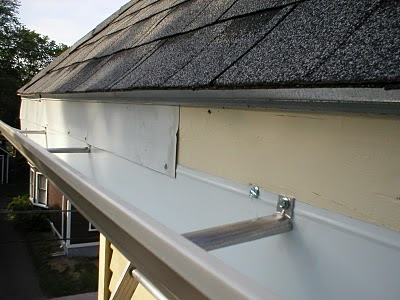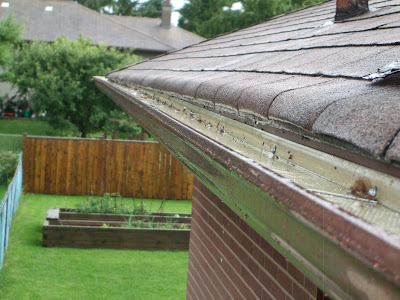 Flashing is a strip of aluminum that is installed for a couple of different reasons. It can be used to bridge the gap between the metal drip edge under the first row shingles and the top of the eavestrough.(picture on left)
Flashing is a strip of aluminum that is installed for a couple of different reasons. It can be used to bridge the gap between the metal drip edge under the first row shingles and the top of the eavestrough.(picture on left)The picture here (to the left) of a home in North York, shows a large gap of wood fascia that is vulnerable to water damage and leaks behind the eavestrough. Usually the gap is not this big but regardless of the size it's important to consider covering none the less. Often the wood is not even painted and may never get painted as most painters do not paint above the eavestrough. If you have aluminum fascia and it extends well up under the shingles then there is no fear of rotting wood, but you still may have drips between the fascia and eavestrough.
Shown here is a simple piece of aluminum flashing.
Flashing is also installed to prevent water from running behind your new eavestroughs due to shingles that may be curled down. (Curled down shingles can be prevented if the roofing company uses a drip edge, which we highly recommend. Do not allow a roofing company to leave the shingles extra long and let them fold down into the eavestrough.) It's surprising how many roofing companies think this is acceptable. Here is the link to our blog post explaining drip edge: http://torontoeavestroughing.blogspot.ca/2010/03/drip-edge-why-its-critical.html
Here is a picture of shingles that have curled down on a home in Scarborough.
When these shingles were new, they were not curled like this and did not let water run behind the eavestrough like it does in the picture below. Many years in the sun allows them to curl down under their own weight. Since eavestroughs are not actually sealed/caulked to the wood or aluminum fascia, proper water flow into the eavestrough depends on proper shingle overhang.
Below we show how the piece of flashing extends over the back of the eavestrough and up under the curled shingles.
The metal flashing must slide up under the drip edge (if you have drip edge) or curled shingles and extend down over the back of the eavestrough.
FAQ : How much flashing will I need? If you need to flash an existing eavestrough system then a simple inspection will reveal how many feet you need. The places where the shingles curl down and overlap the back of the eavestrough will not need flashing. When we price flashing with a new eavestrough system we allow a per foot price as there is no way of determining how much is needed before the new system is in place. This is because there is no way of determining when the eavestroughs will come out from under the curled shingles due to the way the eavestroughs slope down to the downspouts. An average home may need 40 to 100 feet to prevent drips if the shingles are curled down. Flashing starts at $2. per lineal foot depending on installation difficulty.
This video shows how water runs off a shingle. It refers to drip edge but once the shingles have curled down it's easier and cheaper to resolve the problem with flashing. Sometimes the curled shingles do not lift easily (they become brittle or stiff and may crack if lifted) to slide a drip edge onto the roof deck. Flashing is easier and will reduce the chance of damaging the shingles when the metal is being installed.
Its our view at North Shore Eavestroughing that a educated consumer will help raise our industry standards. Visit www. eavestrough.ca for more information. Do you live in Scarborough, North York or other area in or near Toronto, get in touch so we can provie you with a quote.




No comments:
Post a Comment